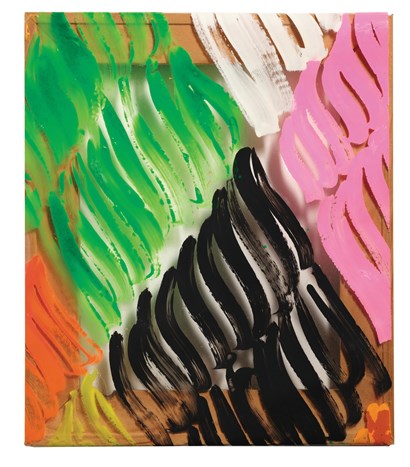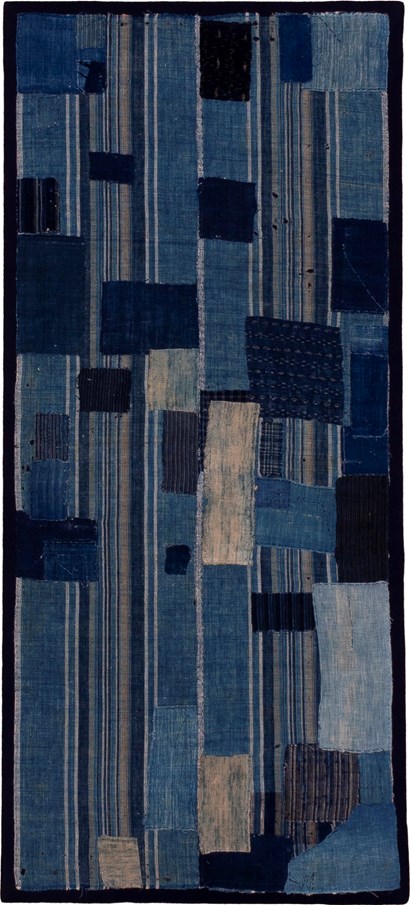This section will be available this Autumn.
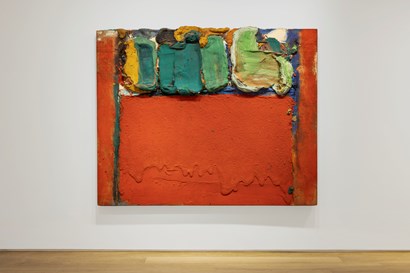
Samuel Vanhoegaerden Gallery
Bram Bogart (Delft 1921-2012 Sint Truiden) Topgroen, August 1963 Mixed media on canvas laid on wooden panel 161 x 201 cm Signed, dated and titled on reverse Provenance: private collection, London In August 1963, Bram Bogart created a powerful and iconic work: Topgroen (August 1963). The painting – executed with homemade paint on a board/canvas made by the artist himself – measures approximately 161 x 201 cm and testifies to Bogart's radically innovative approach to matter and colour. The work Topgroen is at the heart of Bogart's most highly regarded period, in which he experimented with imposing layers of paint, sculptural reliefs and a colour palette that transcends the surface and becomes almost tangible. In this work, he combines powerful fields of colour with monumental texture: an intense red surface is directly framed by thick, almost architecturally shaped green and yellow accents. The paint is hardly imagination anymore, but matter – as if the paint itself is the object. Topgroen marks a turning point in Bogart's oeuvre: colour and volume become one, the painting resists classical painting through an enormous physical presence of the matter. The work invites tactile viewing: the depth of the paint layers, the shadow effects between reliefs, and the tension between surface and volume make it a masterpiece of material painting. Bogart thus confirms his pioneering role in European post-war abstraction.

Van Herck-Eykelberg
Asger Jorn (Denmark, Jutland 1914-1973 Aarhus) The girl and the bird, 1940 Oil on canvas 44 x 69 cm Signed and dated lower right Literature: Guy Atkins, Jorn in Scandinavia 1930-1953, London, 1968, n° 156, ill. p. 333 Exhibitions: 13 kunstnere i telt, Bellevue, Copenhagen, 17 May-8 June 1941, cat. n° 61; Jorn, Arken Museum for Moderne Kunst, Ishøj, Denmark, 14 September 2002-19 January 2003, Cobra Museum voor Moderne Kunst, Amstelveen, The Netherlands, 7 February-27 April 2003 and Kunsthalle zu Kiel, Germany, 17 May-10 August 2003, cat. n° 8, ill. cat. p. 56 (in colour); Jorn-Picasso. Myter og Møder. Myths & Meetings', Museum Jorn, Silkeborg, 7 September-8 December 2013, cat. n° 6, ill. cat. p. 72 (in colour); Cobra Museum voor Moderne kunst, Amstelveen, The Netherlands, 2013

Galerie Haesaerts-le Grelle
Gustave Serrurier-Bovy (Liège, 1858-1910) Silex linen cupboard, circa 1905 Poplar, blue stencils and blue-painted iron H 192 x W 70 x D 45 cm Provenance: Villa de L’Aube, collection of Gustave Serrurier-Bovy, Soyeur-Delvoye Literature: Jacques-Grégoire Watelet, Gustave Serrurier-Bovy, Éditions Beaunord, Paris, 1989, p. 87 Built between 1902 and 1905 on the Cointe hill in Liège, the Villa de L’Aube was the personal home of Gustave Serrurier, a true manifesto of his conception of architecture. He lived there until his death in 1910. Intended for the children’s and staff’s bedrooms, the Silex furniture was made of poplar, assembled with simple iron screws, and decorated - some of it - with painted stencils. First appearing at the Château de La Cheyrelle in 1904, Gustave Serrurier would go on to incorporate the Silex furniture into the layout of his own house. This linen cupboard was part of the original furnishings of the villa.

Claes Gallery
Reliquary Figure 'Mbulu-ngulu' Kota Kota-Obamba People Gabon, presumed late 19th-early 20th century Wood, copper and brass H 43 cm Provenance: private collection, Los Angeles, until 1979; private collection, Geneva Literature: L’Art Kota. Les figures de reliquaire, Chaffin, Meudon, 1979, pp. 234-235, fig. 133 (written height: 43.5 cm)

Brame & Lorenceau
julio gonzález
Julio González (Spain, Barcelona 1876-1942 Arcueil, France) Personnage au cornet, 1937 China ink and coloured pencil on paper 29 x 21 cm Signed and dated lower centre Provenance: private collection Literature: J. Gibert, Catalogue raisonné des dessins de Julio González, Projets pour sculptures personnages, Paris, 1975, vol. 9, p. 47 (ill.) Exhibition: New York, The Museum of Modern Art, Julio González, Drawings and Sculpture, February-April 1956, Minneapolis

Galerie Bernard De Leye
Stag hanap Germany, Melchior Mair, circa 1582-1583 Augsbourg Hall mark Bears the crest of Hans Moser, lord of Pötzleinsdorf from 1571 to 1583 Provenance: Hans Moser, Pötzleinsdorf (near Vienna), 1582-1583; collection Otto Wessner Saint-Gallen, until 1921; sale 'Galerie Fischer', Lucerne, 1922; private collection Switzerland until 2024 Comparative works: Stag hanap, identical to this model, with hallmark from Vienna, after 1582, goldsmith marked with a hunting horn, Waddesdon Bequest, British Museum inv. WB138; Stag hanap, gilded silver, Augsbourg hallmark, 1576-1586, Melchior Bair, Museum of Applied Arts, Budapest
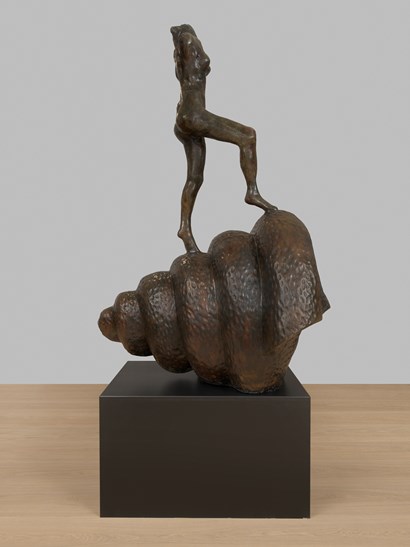
CKS Gallery
Salvador Dalí (Spain, Figueras 1904-1989) Nude ascending the staircase, 1973 Brown patina bronze sculpture H 212 × W 139 × D 117 cm - Height with the base: 297 cm Signed & numbered 'Dalí 2/8', Foundry mark 'Fratelli Bonvicini, Italie' on the shell Certificate of authenticity by M. Robert Descharnes and listed in the Descharnes Archives under the n° 0-264 Provenance: private collection
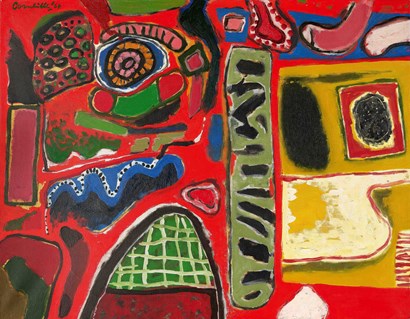
De Zutter Art Gallery
corneille
Corneille (Liège 1922-2010 Auvers-sur-Oise) Le rouge itinéraire de l'été, 1964 Oil on canvas 73 x 92 cm Provenance: Galerie Delta, Rotterdam; kunsthandel Lambert Tegenbosch, Heusden; collection Dr. Johan B.W. Polak (1928-1992), Amsterdam; Christie's, Amsterdam, 10 December 1992, lot n° 325; private collection, Switzerland Literature: Catalogue Galerie Cimaise Bonaparte (Patrick d'Elme and Daniel Templon), 1967, Paris Exhibition: Galerie Cimaise Bonaparte (Patrick d'Elme and Daniel Templon), 1967, Paris
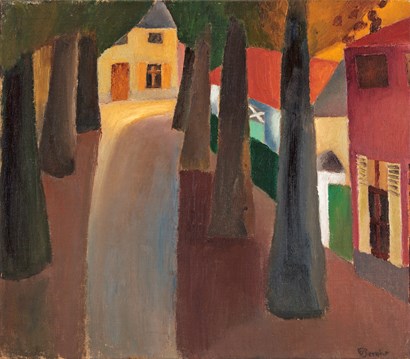
Galerie Oscar De Vos
frits van den berghe
Frits Van den Berghe (Ghent, 1883-1939) Ooidonk alley, 1923 Oil on canvas 48.5 x 55 cm Signed lower right: FVBerghe Provenance: Galerie Campo, Antwerp Literature: Boyens, P., Frits Van den Berghe 1883-1939 (1999), 396, n° 309 (ill.); Servaes, W., V. Van Doorne & R. Van Lerberghe, 1924 Honderd jaar later, exh. cat. (2024), 56-57 (ill. & cover) Exhibition: 2024, Sint-Martens-Latem, Latemse Kunstkring/ Gemeentehuis, 1924 Honderd jaar later, s.n. Ooidonk Alley belongs to the key works of Van den Berghe’s short but decisive stay in Bachte-Maria-Leerne (1922–1923). He lived there at the entrance of the quadruple beech-lined avenue leading directly to Ooidonk Castle. That place was an actual re-grounding – a breakthrough towards a new way of painting that no longer records, but constructs. Here, the Lys landscape is no longer seen ‘from the outside’, but becomes an inner building site. The trunks become cylindrical volumes, the soft bend of the road becomes a carrier of rhythm. The colour language definitively abandons the sombre earth tones of his Ostend years: a new clarity emerges, a ‘new spring’, in which light assumes a plastic role. Ooidonk Alley is thus a document of the moment in which Van den Berghe finds his modernity: pure form, condensed space, a landscape as architecture. This work shows how, at the end of 1922–1923, Van den Berghe redefined the Lys region: as an ordered space of line, colour and spirit – rather than a piece of nature.

TEMPLON
Martial Raysse (Nice, 1936) Now, 2017 Acrylic on canvas 209 x 175.5 cm Unique Provenance: the artist’s studio Literature: exhibition catalogue Martial Raysse: œuvres récentes, Musée Paul Valéry, Sète, France: Ed. Loubatières 2023, ill. p. 151 Exhibition: Martial Raysse: œuvres récentes, Musée Paul Valéry, Sète France, 2023

Galerie Hadjer
fernand léger
Fernand Léger (Argantan 1881-1955 Gif-sur-Yevette) (after) & Yvette Cauquil-Prince (Belgium, Dampremy 1928-2005 Tresques, France) La parade sur fond rouge Created in 1975 Wool 280 x 400 cm Woven by Yvette Cauquil-Prince in Paris (pictogram lower right) Tapestry number 1/1 - Unique Piece Provenance: Yvette Cauquil-Prince; Paul Haim collection; private collection, USA Literature: Masters of the 20th century, KunstHausWien Exhibition: KunstHausWien, 10 February-14 May 2000, Vienna
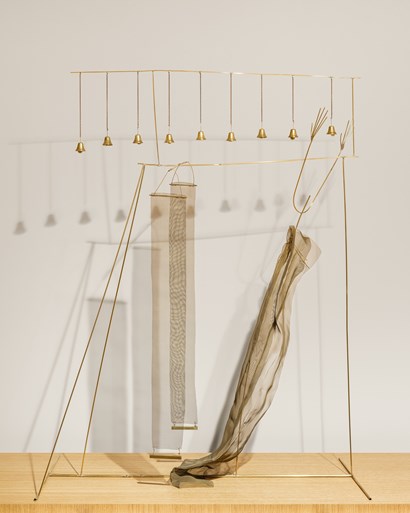
Pron
fausto melotti
Fausto Melotti (Rovereto 1901-1986 Milan) Il meridiano delle campane, 1979 Brass H 97.5 x W 74 x D 38 cm Literature: Milan, Galleria Stendhal, Cascella Consagra Melotti, 1980; Padua, Stevenson Arte Contemporanea, Fausto Melotti. Sculture, tecniche miste e incisioni, 1982; Intra, Galleria Corsini, Fausto Melotti. Sculture e Acquarelli. Un'opera d'arte è un'oasi, 1982; Busto Arsizio, Galleria Il Punto Sette, Fausto Melotti, 1984; Parma, Galleria La Sanseverina, Fausto Melotti, 1986, pp. 29, 47, n° 29, ill. Exhibitions: Gianni Cavazzini, Poetiche sosprese di Fausto Melotti, in Gazzetta di Parma, May 23rd, 1986, ill.; Germano Celant, Melotti, Catalogo generale, Tomo secondo, Sculture 1973-1986 e Bassorilievi, Milan 1996, p. 512, 1979 n° 21, ill.
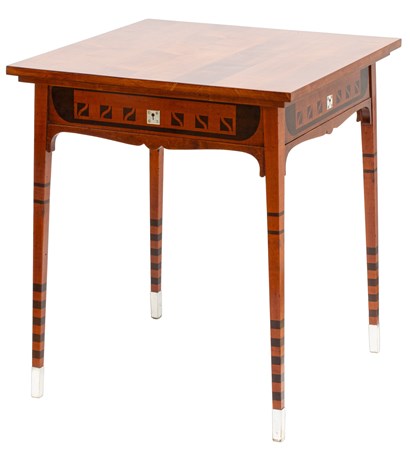
Florian Kolhammer
joseph maria olbrich
Joseph Maria Olbrich (Czech Republic 1867-1908 Germany) & Josef Hoffmann (Czech Republic 1870-1956 Austria) Secessionist side table, circa 1900 Solid maple, inlaid ebony and white metal H 70 x W 56 x D 56 cm Provenance: private collection, Austria Literature: Josef Maria Olbrich, Ideen von Olbrich, 2nd edition, Leipzig 1904, p. 67; Association of Austrian Visual Artists (ed.), Ver Sacrum.Vereinigung Bildender Künstler Österreichs (Hrsg.), Ver Sacrum. Mittheilungen der Vereinigung Bildender Künstler Österreichs, 1900, 1st issue, pp. 4, 9 & 15 Exhibition: displayed at the fifth exhibition of the Vienna Secession 1899 This elegant Secessionist side table was created around 1900 through the collaboration of two influential artists of Viennese Modernism: Joseph Maria Olbrich and Josef Hoffmann. The design of the table's body by Olbrich was first published in 1899 in 'Ideen von Olbrich'. The characteristic ornament was originally designed by Hoffmann as a decorative frieze for the fifth Secession Exhibition and documented in the magazine 'Ver Sacrum' (1900). It is highly probable that this furniture piece was specially created for this exhibition. Particularly noteworthy are the original design drawing by Olbrich and the ornament by Hoffmann. The exceptional quality and characteristic fittings strongly suggest production by the renowned Viennese art furniture workshop Portois & Fix, famous for numerous designs associated with the Vienna Secession, predominantly by Hoffmann.
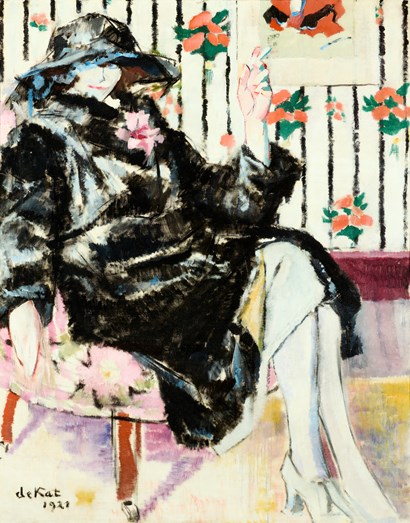
Galerie Raf Van Severen
anne-pierre de kat
Anne-Pierre De Kat (The Netherlands, Delft 1881-1968 La Frette-sur-Seine, France) Femme à la cigarette, 1921 Oil on canvas 102 x 80 cm Signed bottom left Provenance: private collection, Knokke-Heist Literature: Paul Caso, Anne-Pierre De Kat, Une vive intelligence visuelle, Les Editeurs d'Art Associés Exhibition: Guillaume Campo, Meir 47-55 Antwerpen, Exposition n° 121 (label at the back)
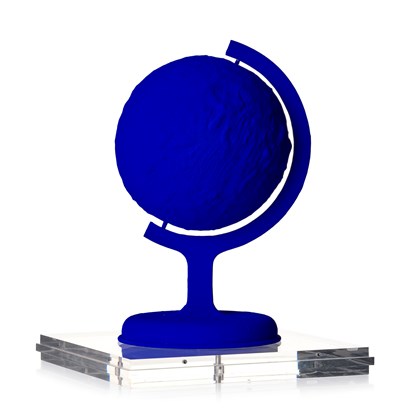
Guy Pieters Gallery
yves klein
Yves Klein (Nice 1928-1962 Paris) La Terre Bleue, 1957 IKB Pigment H 41 x Ø 29 cm Provenance: Galerie Bonnier, Geneva; private collection, Sweden Literature: P. Wember, Yves Klein, Cologne, 1969, p. 109, n° RP7 (another example ill.); P. Restany, Yves Klein, New York, 1982, p. 226 (another example ill.); J.P. Ledeur, Yves Klein: Catalogue of Editions and Sculptures Edited, Belgium, 1999, p. 242 (another example ill.); N. Charlet, Yves Klein, Paris, 2000, p. 230 (another example ill.); H. Weitemeier, Yves Klein: International Klein Blue, Cologne, 2001, p. 83 (another example ill.) Exhibitions: Paris, Centre Georges Pompidou Musée National d'Art Moderne, Yves Klein, March-May 1983, p. 109, n° 56 (another example exh.); Nice, Musée d'Art Moderne et d'Art Contemporain and Museo Pecci Prato, Yves Klein: Long Live the Immaterial!, April 2000-January 2001, p. 184 (another example exh. and ill.); Musée des Beaux-Arts d'Angers, Marie Raymond, Yves Klein, November 2004-February 2005, p. 190 (another example exh. and ill.)

Galerie Haesaerts-le Grelle
Gustave Serrurier-Bovy (Liège, 1858-1910) Coat rack, circa 1905 Painted iron, brass, and enameled cast iron H 204 cm – Ø 63 cm Literature: Bigot du Mesnil du Buisson, F. & du Mesnil du Buisson, E., Serrurier-Bovy – un créateur précurseur – 1858–1910, Paris, Faton, 2008, p.166-167; Jacques-Grégoire Watelet, Serrurier-Bovy, Ateliers Vokaer, Brussels, 1986, p. 109 Designed in 1905 for the former Marchal confectionery shop on rue de l’Écuyer in Brussels, this sculptural work in iron and brass, measuring over two metres in height, embodies the very essence of the artist’s genius as a leading figure of Belgian Art Nouveau.
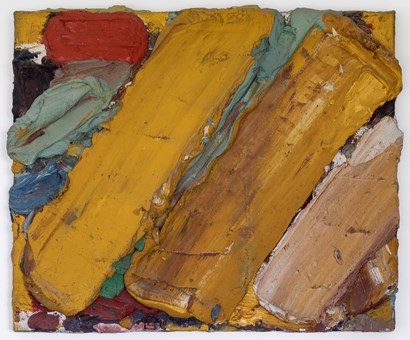
Samuel Vanhoegaerden Gallery
Bram Bogart (Delft 1921-2012 Sint Truiden) Hooigang, September 1964 Mixed media on canvas, mounted on wooden panel 106 x 124 cm Signed, dated and titled on reverse Provenance: D & R Hughes, London, 1989; private collection, Belgium Literature: Bram Bogart, The early years, 1951-1965, D & R Hughes, 1989, ill. n° 49







